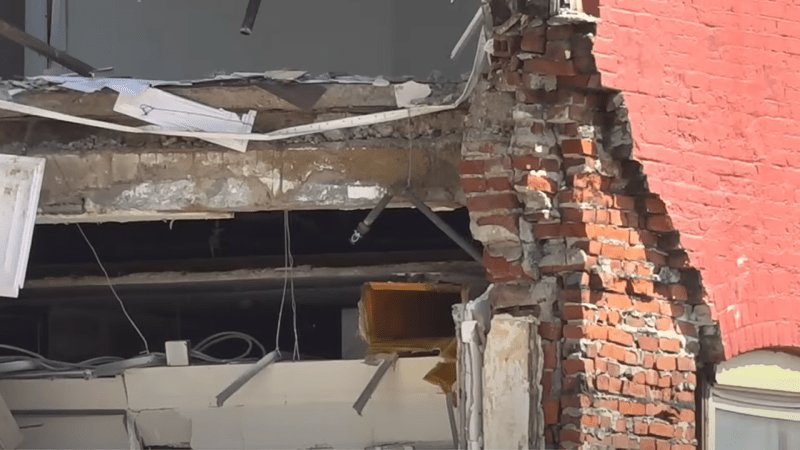Below are several items in the lawsuit that dik just posted a link to.
These are the relevant sections pertaining to the structural engineer (with my comments)
[blue]
96. However, once the extremely dangerous condition of the exterior west wall was observed, Mr. Valliere and Defendant Select Structural Engineering did absolutely nothing to warn the tenants and occupants of the building of this imminently dangerous condition that was putting their lives in grave and immediate danger.
97. The very first fundamental canon of the National Society of Professional Engineers Code of Ethics is that professional engineers must “Hold paramount the safety, health, and welfare of the public.” Mr. Valliere violated this sacred fundamental canon when he failed to take any action whatsoever to warn the tenants of The Davenport of the imminent danger posed by the structural instability of the exterior west wall or otherwise sound the alarms and call for the evacuation of the building until it could be made safe. [/blue]
I think that many past times I have been hesitant to go “around” my client to notify government authorities or local tenants of safety conditions as I feel I am an agent, so to speak, of my client and would typically rely on my client to decide to evacuate a building. Hasn’t happened often but I can see Mr. Valliere’s perspective in simply warning the client and depending on them to warrant the “safety and welfare of the public”. However, this event shows that we engineers shouldn’t be this passive when a structural collapse is a real concern.
[blue]
98. Mr. Valliere and Select Structural Engineering knew or should have known that failing to warn the tenants of The Davenport or immediately recommend or call for the evacuation of the building in light of the imminent danger would foreseeably expose the tenants and occupants of The Davenport, including Plaintiff, to an unreasonable and unacceptable risk of severe injury and/or death.
99. Despite this aforementioned knowledge, Mr. Valliere and Defendant Select Structural Engineering knowingly failed to warn the tenants of The Davenport of the imminent danger or call for the evacuation of the building until it could be made safe.
112. On May 23, 2023—just five days before this tragic collapse—Mr. Valliere of Select Structural Engineering made another visit to the site. His findings at this inspection were alarming and should have raised immediate red flags to the Wold Defendants, and the City of Davenport that an immediate evacuation of the building was required to protect the health and safety of the tenants and occupants of the building.
113. There is no excuse for Mr. Valliere not doing everything possible to ensure the building was evacuated based on his observations during this visit. ]/b]
114. In a May 24, 2023 report, Mr. Valliere notes that on the exterior west wall “there are several large patches of clay brick façade which are separating from the substrate large patches appear ready to fall imminently, which may create a safety hazard to cars or passersby.
[/blue]
Note that here Mr. Valliere appears to be primarily concerned with exterior safety issues (cars or passerby). This makes me wonder if he wasn’t cognizant of the interior structural framing system and only concerned with the exterior wall as an enclosure, vs. a vital element in supporting six levels of floor. He did earlier indicate the need for an interior post to support a single beam, but the reports issued by Select Structural all appear to be mostly focused on the exterior.
[blue]
115. Mr. Valliere observed that “there are two former window openings, roughly 12 feet tall by six feet wide, which appear to have been bricked over some years ago. The clay brick façade on and between these openings is bulging outward by several inches and looks poised to fall. In anticipation of these areas falling, the brick façade above the windows should be secured. This is to keep the entire face of the building from falling away when the bottom area(s) come loose.”[/blue]
Here the attorneys zero in on what is probably the main legal danger to the engineer, the lack of acting on engineering knowledge to warn the public.
[blue]
119. Mr. Valliere and Select Structural Engineering knew or should have known that failing to warn the tenants and occupants of The Davenport of the grave and imminent danger they were in or otherwise call for the immediate evacuation of the building would foreseeably expose the residents, including Plaintiff, to an unreasonable and unacceptable risk of severe injury and/or death.
120. Despite this aforementioned knowledge, Mr. Valliere and Select Structural Engineering outrageously and recklessly remained silent, and knowingly failed to warn the tenants and occupants of The Davenport of the grave and imminent danger they were in or otherwise call for the immediate evacuation of the building to safeguard the residents’ lives.
121. Mr. Valliere and Select Structural Engineering turned their backs on the sacred fundamental canon of their ethical code to “Hold paramount the safety, health, and welfare of the public.” [/blue]
If anything this certainly should warn all of us here to keep the public safety paramount in our work, separate and transcendent over our contractual obligations to our clients.

